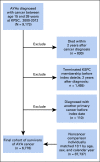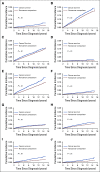Chronic Comorbidities Among Survivors of Adolescent and Young Adult Cancer
- PMID: 32673152
- PMCID: PMC7499612
- DOI: 10.1200/JCO.20.00722
Chronic Comorbidities Among Survivors of Adolescent and Young Adult Cancer
Abstract
Purpose: To describe the incidence, relative risk, and risk factors for chronic comorbidities in survivors of adolescent and young adult (AYA) cancer.
Methods: This retrospective cohort study included 2-year survivors of AYA cancer diagnosed between age 15 and 39 years at Kaiser Permanente Southern California from 2000 to 2012. A comparison cohort without cancer was individually matched (13:1) to survivors of cancer on age, sex, and calendar year. Using electronic medical records, all participants were followed through December 31, 2014, for chronic comorbidity diagnoses. Poisson regression was used to evaluate the association between cancer survivor status and risk of developing each comorbidity. The associations between cumulative exposure to chemotherapy and radiation therapy and selected comorbidities were examined for survivors of cancer.
Results: The cohort included 6,778 survivors of AYA cancer and 87,737 persons without a history of cancer. The incidence rate ratio (IRR) for survivors of cancer was significantly increased for nearly all comorbidities examined. IRR ranged from 1.3 (95% CI, 1.2 to 1.4) for dyslipidemia to 8.3 (95% CI, 4.6 to 14.9) for avascular necrosis. Survivors of AYA cancer had a 2- to 3-fold increased risk for cardiomyopathy, stroke, premature ovarian failure, chronic liver disease, and renal failure. Among survivors of cancer, significant associations between chemotherapy and radiation therapy exposures and late effects of cardiomyopathy, hearing loss, stroke, thyroid disorders, and diabetes were observed from the multivariable analyses. Forty percent of survivors of AYA cancer had multiple (≥ 2) comorbidities at 10 years after index date, compared with 20% of those without cancer.
Conclusion: Risk of developing comorbidities is increased in survivors of AYA cancer compared with the general population. Specific cancer treatment exposures were associated with risk of developing different comorbidities. These findings have important implications for survivorship care planning and patient education.
Figures




Similar articles
-
Incidence, Risk Factors, and Mortality Associated With Second Malignant Neoplasms Among Survivors of Adolescent and Young Adult Cancer.JAMA Netw Open. 2019 Jun 5;2(6):e195536. doi: 10.1001/jamanetworkopen.2019.5536. JAMA Netw Open. 2019. PMID: 31173129 Free PMC article.
-
Cardiovascular Disease Risk Profiles in Survivors of Adolescent and Young Adult (AYA) Cancer: The Kaiser Permanente AYA Cancer Survivors Study.J Clin Oncol. 2016 May 10;34(14):1626-33. doi: 10.1200/JCO.2015.65.5845. Epub 2016 Mar 7. J Clin Oncol. 2016. PMID: 26951318
-
Chronic health conditions among long-term survivors of adolescent and young adult cancer: A comparison of outcomes in Israel and the United States.Cancer. 2023 Jun 1;129(11):1763-1776. doi: 10.1002/cncr.34740. Epub 2023 Mar 17. Cancer. 2023. PMID: 36929478
-
Cognitive Impairment in Survivors of Adolescent and Early Young Adult Onset Non-CNS Cancers: Does Chemotherapy Play a Role?J Adolesc Young Adult Oncol. 2016 Sep;5(3):226-31. doi: 10.1089/jayao.2015.0025. Epub 2016 Apr 14. J Adolesc Young Adult Oncol. 2016. PMID: 27078009 Review.
-
Clinical Care for People Who Survive Childhood Cancer: A Review.JAMA. 2023 Sep 26;330(12):1175-1186. doi: 10.1001/jama.2023.16875. JAMA. 2023. PMID: 37750876 Review.
Cited by
-
Patient-Reported Outcomes of Accelerated Aging: A Novel Approach to Investigate Second Cancer Risk in Adolescent and Young Adult (18-39 Years) Cancer Survivors.Oncologist. 2024 Apr 4;29(4):e526-e534. doi: 10.1093/oncolo/oyad307. Oncologist. 2024. PMID: 37995309 Free PMC article.
-
Subsequent Primary Cancer Risk Among 5-Year Survivors of Adolescent and Young Adult Cancers.J Natl Cancer Inst. 2022 Aug 8;114(8):1095-1108. doi: 10.1093/jnci/djac091. J Natl Cancer Inst. 2022. PMID: 35511931 Free PMC article.
-
Higher Incidence of Diabetes in Cancer Patients Compared to Cancer-Free Population Controls: A Systematic Review and Meta-Analysis.Cancers (Basel). 2022 Apr 2;14(7):1808. doi: 10.3390/cancers14071808. Cancers (Basel). 2022. PMID: 35406580 Free PMC article. Review.
-
Adolescent and Young Adult (AYA) Cancer Survivorship Practices: An Overview.Cancers (Basel). 2021 Sep 28;13(19):4847. doi: 10.3390/cancers13194847. Cancers (Basel). 2021. PMID: 34638332 Free PMC article. Review.
-
Precision Medicine for Adolescent and Young Adult (AYA) Oncology.J Pers Med. 2023 Sep 29;13(10):1449. doi: 10.3390/jpm13101449. J Pers Med. 2023. PMID: 37888060 Free PMC article.
References
-
- Bleyer A, O’Leary M, Barr R, et al: Cancer epidemiology in older adolescents and young adults 15 to 29 years of age, including SEER incidence and survival: 1975-2000. http://seer.cancer.gov/publications/aya/
-
- Hellmann K. Dexrazoxane-associated risk for secondary malignancies in pediatric Hodgkin’s disease: A claim without evidence. J Clin Oncol. 2007;25:4689–4691. - PubMed
-
- Keegan TH, Ries LA, Barr RD, et al. Comparison of cancer survival trends in the United States of adolescents and young adults with those in children and older adults. Cancer. 2016;122:1009–1016. - PubMed
Publication types
MeSH terms
Substances
Grants and funding
LinkOut - more resources
Full Text Sources
Other Literature Sources
Medical

